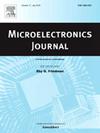A 14-bit 750 MS/s energy-efficient pipelined ADC for MEMS LiDAR system
IF 1.9
3区 工程技术
Q3 ENGINEERING, ELECTRICAL & ELECTRONIC
引用次数: 0
Abstract
This paper proposes a 14-bit 750 MS/s energy-efficient pipelined analog-to-digital converter (ADC) used in MEMS LiDAR system for time-of-flight (TOF) measurement. In this work, a novel opamp sharing technique is presented based on splitting multiplexing digital-to-analog converters (MDACs), thereby increasing the duty cycle of the residue amplifier to 100 % and reducing its power consumption to 25 % compared to the traditional case. Besides, the capacitor sharing method is incorporated in the prototype between the first two stages for a considerable reduction in effective load capacitance to relax the power budget further. The ADC prototype was fabricated in a 28 nm CMOS technology with an area of 0.138 mm2. With an input frequency of 103 MS/s, it achieves 76.4 dB spurious-free dynamic range (SFDR), while consuming 153.6 mW from a 2.5 V power supply. Adopting our high power- and area-efficient pipelined ADC in LiDAR TOF system, the ideal ranging accuracy can potentially reach ±20 cm, along with such a high SFDR, which significantly enhances the precision of the resulting 3D point cloud imaging.
求助全文
约1分钟内获得全文
求助全文
来源期刊

Microelectronics Journal
工程技术-工程:电子与电气
CiteScore
4.00
自引率
27.30%
发文量
222
审稿时长
43 days
期刊介绍:
Published since 1969, the Microelectronics Journal is an international forum for the dissemination of research and applications of microelectronic systems, circuits, and emerging technologies. Papers published in the Microelectronics Journal have undergone peer review to ensure originality, relevance, and timeliness. The journal thus provides a worldwide, regular, and comprehensive update on microelectronic circuits and systems.
The Microelectronics Journal invites papers describing significant research and applications in all of the areas listed below. Comprehensive review/survey papers covering recent developments will also be considered. The Microelectronics Journal covers circuits and systems. This topic includes but is not limited to: Analog, digital, mixed, and RF circuits and related design methodologies; Logic, architectural, and system level synthesis; Testing, design for testability, built-in self-test; Area, power, and thermal analysis and design; Mixed-domain simulation and design; Embedded systems; Non-von Neumann computing and related technologies and circuits; Design and test of high complexity systems integration; SoC, NoC, SIP, and NIP design and test; 3-D integration design and analysis; Emerging device technologies and circuits, such as FinFETs, SETs, spintronics, SFQ, MTJ, etc.
Application aspects such as signal and image processing including circuits for cryptography, sensors, and actuators including sensor networks, reliability and quality issues, and economic models are also welcome.
 求助内容:
求助内容: 应助结果提醒方式:
应助结果提醒方式:


